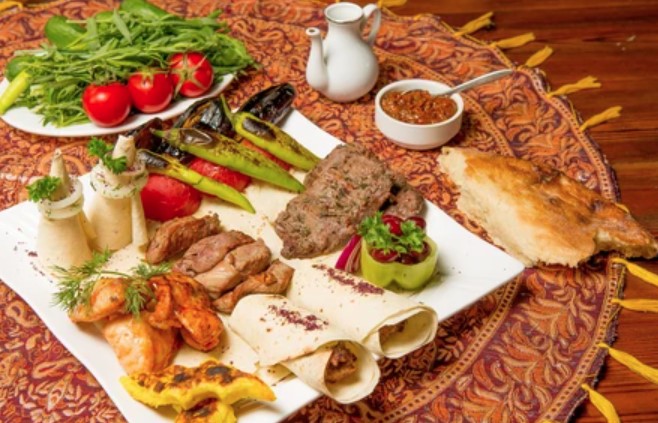Introduction to Azerbaijani Cuisine
Azerbaijani cuisine is a fusion of various cooking traditions from the Caucasus, Middle East, and Central Asia. The cuisine of Azerbaijan is known for its rich flavor, unusual ingredients, and vibrant colors. Azerbaijani cuisine is often characterized by its use of fresh herbs, vegetables, fruits, and meats, which are readily available in the region.
History and Influences of Azerbaijani Cuisine
The history of Azerbaijani cuisine dates back to ancient times, and it has been influenced by various cultural and historical events. The cuisine of Azerbaijan has been shaped by the country’s geographical location, which has made it a melting pot of different cultures and traditions. This fusion of cultures has resulted in a unique cuisine that combines flavors and techniques from different regions. The influence of Persian, Turkish, and Russian cuisine is evident in Azerbaijani food, which is often referred to as “the cuisine of the Silk Road.”
Unique Ingredients in Azerbaijani Dishes
Azerbaijani cuisine is characterized by its use of unusual ingredients, such as saffron, sumac, pomegranate, and sour cherry. These ingredients are used in various dishes to add flavor, color, and texture. Another unique ingredient is yogurt, which is used in many Azerbaijani dishes, including soups, stews, and kebabs. Azerbaijani dishes also often feature lamb, beef, chicken, and fish, which are grilled, roasted, or stewed to perfection.
Cooking Techniques in Azerbaijani Cuisine
Azerbaijani cuisine is known for its use of various cooking techniques, including grilling, stewing, and baking. Many Azerbaijani dishes are prepared on open flames, which gives the food a smoky, charred flavor. Azerbaijani cuisine also features a unique cooking method called “plov,” which is similar to pilaf. Plov is a rice dish that is cooked in a large pot with meat, vegetables, and spices.
Popular Azerbaijani Dishes and their Characteristics
Some of the most popular Azerbaijani dishes include dolma (stuffed vegetables), kebab (grilled meat), pilaf (rice dish), and dushbara (meat dumplings). Dolma is a dish made with vine leaves or vegetables, filled with a mixture of ground meat, rice, and spices. Kebabs are grilled meats that are marinated in spices and herbs, and often served with vegetables and bread. Pilaf is a rice dish that is cooked with meat, vegetables, and spices, while dushbara is a soup made with small meat dumplings.
Comparison of Azerbaijani Cuisine with other Middle Eastern Cuisines
Azerbaijani cuisine is unique from other Middle Eastern cuisines due to its diverse influences and ingredients. While some dishes may be similar to those found in other regions, Azerbaijani cuisine has its own distinct flavors and cooking techniques. For example, while the use of lamb is common in many Middle Eastern cuisines, Azerbaijani cuisine often uses beef and chicken as well.
Regional Variations in Azerbaijani Cuisine
There are regional variations in Azerbaijani cuisine, with each region having its own specialties and cooking traditions. The cuisine of Baku, the capital city, is known for its seafood dishes, while the cuisine of Ganja is renowned for its sweets and pastries. The cuisine of Nakhchivan, an exclave of Azerbaijan, features lamb and yogurt-based dishes.
Conclusion: What sets Azerbaijani Cuisine Apart?
Azerbaijani cuisine is a unique blend of various cultural and historical influences, resulting in a cuisine that features distinct flavors, ingredients, and cooking techniques. The use of unusual ingredients, such as saffron and pomegranate, and cooking techniques, such as grilling and stewing, set Azerbaijani cuisine apart from other Middle Eastern cuisines. The regional variations in the cuisine also add to its diversity and richness. Azerbaijani cuisine is a must-try for anyone who wants to experience the flavors of the Caucasus and the Silk Road.

